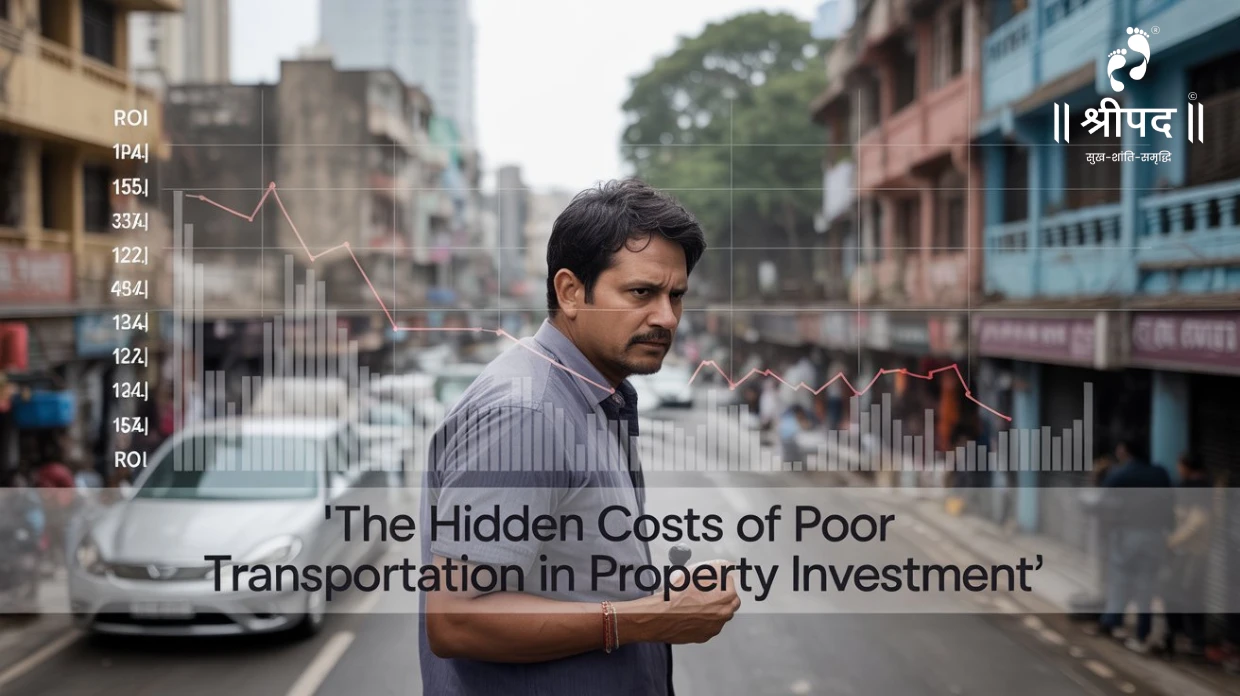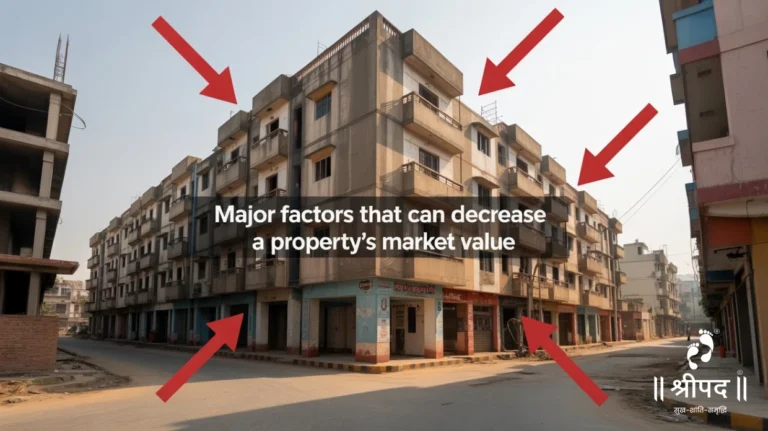- SHREEPAD GROUP
-
+91 83476 68000

When buyers or investors evaluate real estate opportunities, they often focus on price appreciation, modern amenities, rental demand, or the prestige of the locality. Yet, one factor that is often underestimated—but has a direct impact on long-term property performance—is transportation infrastructure.
A property may boast luxury features, but if it lacks reliable roadways, metro access, or easy connectivity, it becomes less appealing to residents and investors alike. Poor transportation doesn’t just inconvenience residents—it erodes property value, limits rental potential, and creates challenges in resale. Understanding the importance of accessibility and transportation in real estate helps investors avoid such pitfalls and choose properties that guarantee long-term growth.
In this blog, we’ll uncover the hidden costs of investing in properties located in areas with poor connectivity and explain why transportation is a make-or-break element in property success.
Why Transportation Shapes Real Estate Success
In real estate, “location” has always been king. But what makes a location valuable? Beyond nearby amenities and social infrastructure, seamless connectivity is what truly defines a prime address.
- Shorter commute times increase resident satisfaction and attract tenants.
- Access to major transport hubs like highways, airports, and metro stations boosts property demand.
- Reliable public transport ensures affordability and convenience for middle-class and working families.
- Smooth last-mile options (good roads, rickshaw stands, cab access) enhance livability.
Without these elements, even a seemingly well-located property can lose its competitive edge.
The Hidden Financial Burdens of Poor Transportation
Transportation challenges don’t always show up immediately when buying a property—but over time, they surface as financial setbacks for investors and homeowners.
Slower Property Value Growth
Properties located near metro stations, expressways, or airports consistently outperform those in isolated neighborhoods. In contrast, poorly connected zones lag behind in appreciation, leaving investors with stagnant returns.
Lower Rental Demand and Yields
Renters prioritize convenience. If transportation is a hassle, they will quickly look elsewhere. Poorly connected properties often fetch lower rents and struggle to attract quality tenants.
Long Vacancies Between Tenants
A well-connected property gets snapped up quickly. Properties in inaccessible areas may sit empty for months, leading to loss of income. Each vacancy represents a hidden cost many investors fail to anticipate.
High Tenant Turnover
Even if you manage to attract tenants, they may not stay long if they face endless traffic or difficult commutes. High churn means additional costs in brokerage, repainting, and repairs after every move-out.
Declining Resident Satisfaction
Time wasted in long commutes affects work-life balance, creating stress for residents. Dissatisfaction eventually reflects in poor word-of-mouth, negative reputation for the property, and reduced demand.
Extra Travel and Maintenance Expenses
Bad roads and longer drives lead to more fuel consumption, higher vehicle wear and tear, and wasted hours on the road. These costs discourage both tenants and buyers from choosing such locations.
Slower Commercial Growth in Surroundings
Well-connected neighborhoods attract shopping centers, offices, restaurants, and entertainment venues. Areas with weak transport networks fail to develop socially and commercially, which further restricts property appreciation.
Difficulty in Resale
When the time comes to sell, fewer buyers will be willing to invest in a poorly accessible area. This reduces liquidity and forces sellers to compromise on price.
How Connectivity Impacts Property Value: Real Examples
Metro and Highway Influence in Indian Cities
Cities like Bengaluru, Pune, and Delhi have shown that properties near metro routes or highways appreciate significantly faster. Areas far from these networks, however, struggle to keep up, even if they initially offered cheaper land or housing.
Surat’s Transformation with Infrastructure
Surat has rapidly emerged as a major growth hub. Its textile and diamond industries, coupled with upcoming transportation projects like the Surat Metro and better airport connectivity, are pushing demand for properties in accessible locations. Investors in well-connected parts of Surat are already seeing stronger appreciation compared to those in less developed outskirts.
Checklist for Choosing Properties with Strong Connectivity
To avoid the pitfalls of poor transportation, investors should carefully evaluate accessibility before committing to a purchase. Here’s a quick guide:
- Proximity to major highways and arterial roads for easy citywide access.
- Distance from metro or railway stations—shorter distances increase demand.
- Upcoming government projects like flyovers, expressways, or metro corridors.
- Ease of last-mile travel with rickshaws, cabs, or shuttle services.
- Growth potential—commercial offices and malls usually develop around well-connected zones.
- Master plans and urban development policies that indicate future infrastructure growth.
By analyzing these factors, investors can safeguard themselves against the hidden costs of poor transportation.
Minimizing Risks if Investing in Developing Areas
Not every high-growth corridor is perfectly connected today. But if investors spot future infrastructure potential, the returns can be significant. To minimize risks:
- Study government urban planning reports to identify upcoming metro lines or expressways.
- Choose reputed builders who prioritize connectivity when selecting project sites.
- Balance your portfolio—combine safe bets in established zones with calculated risks in emerging areas.
- Monitor real estate market news to track infrastructure updates.
Surat: Where Connectivity Fuels Growth
Surat is a shining example of how infrastructure can transform a city’s real estate landscape. The city is growing rapidly with:
- The Surat Metro Rail Project, which will drastically reduce travel times.
- Upgraded Surat International Airport, improving national and global connectivity.
- Expanding ring roads and expressways, linking emerging suburbs to commercial hubs.
- Smart city initiatives, ensuring future-ready infrastructure.
For investors, this means one thing: choosing projects in well-connected parts of Surat today will bring higher appreciation and better rental returns tomorrow.
Why Working with the Right Developer Matters
Not all properties in Surat will benefit equally from transportation upgrades. Developers who understand the importance of location and connectivity deliver projects that stand out in terms of livability and investment potential.
Shreepad Group has built a reputation for selecting prime, well-connected areas for its projects. This ensures that residents enjoy both convenience and lifestyle, while investors benefit from superior appreciation and rental demand.
Final Thoughts
Transportation is not a secondary consideration in property investment—it’s one of the core pillars of value creation. Properties in areas with weak connectivity may look affordable at first but often drain investors with hidden costs like poor appreciation, lower rents, and resale challenges.
Surat, with its booming infrastructure and well-planned transportation upgrades, offers excellent opportunities for those who choose wisely.
If you want to secure your investment in a city poised for exponential growth, explore real estate projects in Surat by Shreepad Group—where strategic locations, seamless connectivity, and modern living come together for long-term success.
See Related News & Insights Blog

09.10.2025
How to Select the Right Property Type to Suit Your Needs
Purchasing a property is one of the most important financial decisions you can make. Whether it’s your first home, an...

09.10.2025
Essential Tips for Investing in a Growing Real Estate Market
Investing in real estate can be one of the smartest financial decisions when approached with knowledge and strategy. A thriving...

09.10.2025
Major Factors That Can Decrease a Property’s Market Value
In the real estate world, property value is more than just a number — it reflects the strength of your...

09.10.2025
Property Due Diligence Checklist for Buyers: Your Ultimate Guide
Purchasing a property is one of the biggest investments in life. Whether it’s a residential apartment, a commercial space, or...
